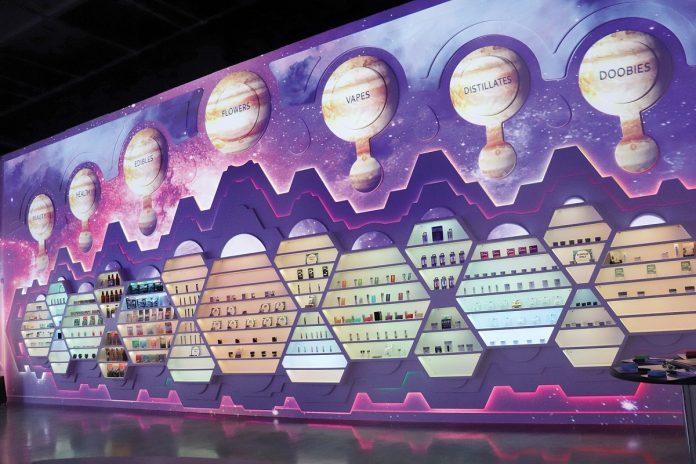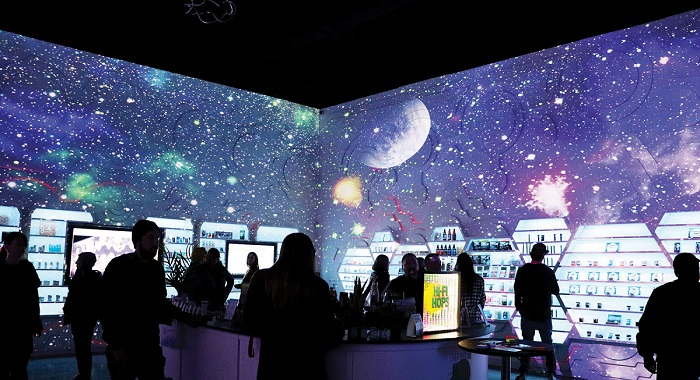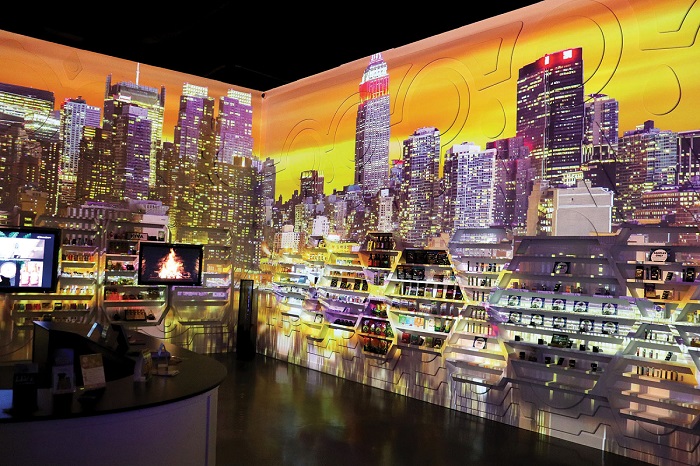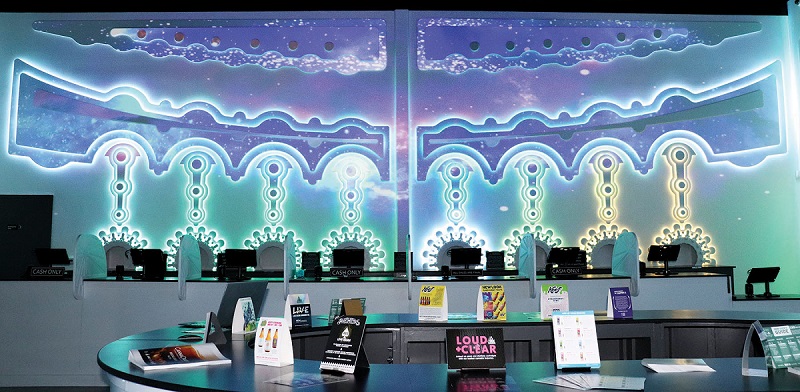
Northern California long has been a magnet for weed enthusiasts, radicals, and counterculture characters of all stripes. Doobie Nights, a new dispensary in Santa Rosa, California, pays homage to the region’s trippy-dippy history by creating a tech-savvy, psychedelic retail shop meant to transport customers from the daily grind into another dimension.
Visitors enter through a portal—a large, round opening in the wall fitted with curved LED screens that bend along the full circumference, projecting images. Once in the main room, they experience a rotating cinematic display of lights, sounds, and images projected onto the walls. Architecturally mapped LED lighting, sculptures, and shifting 3D projections augment the surreal experience.
Doobie Nights co-founder and general manager Damon Crain knew he would have to set a high bar to impress locals and wanted to give them an extraordinary, sensory-bending experience while they are shopping.
“What we wanted to do was an immersion that will take people to a different place,” said Crain. “Then we said, we need to do something absolutely different from retail, so we looked into 3D projection mapping, which is a new technology that’s becoming more mainstream. We decided to do that inside a building, and this is the first time it has been done in a permanent installation inside a retail space.”
A fire sparked a store
Crain sounds like a visionary architect when he talks about dispensary design, but just a few years ago he was one of many cultivators in the area who lost their farms to the Tubbs fire, which ripped through Northern California in 2017. The event provided a harsh reality check for him and many others in the industry during the first year after recreational legalization.
“After the fire I said, ‘What am I going to do next?’ And so I just decided to build this place and then I went looking for partners,” he said.
His partner, Brandon Levine, started one of the first dispensaries in the area, Mercy Wellness, which has been in business for about ten years. “We trained all our employees at Mercy Wellness before we were open, so that was a big help,” Crain said. “They just stepped in ready to go with the new [point-of-sale] system, and Brandon gave us all the stuff that he already knew. So, that really was a launching pad for us.”

The 3,700-square-foot space at Doobie Nights is a rotating mix of scenes projected onto the walls. Each scene embeds customers in exotic places: far-out galaxies, Egyptian pyramids, waterfalls, snow-covered forests, and tropical islands. Several hidden 4K laser projectors project the scenes, and the multi-sensory experience is rounded out by a soundtrack of synchronized music pulsing through speakers situated behind the walls.
Crain also commissioned local artists to layer the walls with sculptures and paintings so there would be some interplay between the physical and digital worlds. Hundreds of sculptures are illuminated with 25,000 LED lights that are also blended with projection-mapped digital art and animation. Carey Thompson, founder of Galactivation, and Brian Pinkham of Photonic Bliss were two of the designers for the project. Both developed the technology components and served as technical advisors along the way.
Space-age shopping
Beyond the technological razzle-dazzle, Doobie Nights’ founders want to ensure customers have a gratifying experience shopping, because for many of them it’s a maiden voyage.
In the main showroom, products are elegantly displayed on illuminated honeycomb shelves that are programmed to change colors throughout the day. When customers enter the room, they are greeted by a cannabis consultant with an iPad in hand to take orders and answer questions or make suggestions. Likewise, customers can help themselves via interactive, wall-mounted touch screens that reveal detailed information about products and brands.
Once a customer places an order, it’s sent to the inventory room for fulfillment, then loaded onto a dumbwaiter. When the customer is ready to pay, the sales associate presses a button and the order appears through a portal, as though beaming in from another part of the galaxy. Presto magico, weed!

Crain explained a large part the store’s base is composed of new, “green” customers, along with lots of millennials who enjoy checking out the far-out digital scenery. While the younger customers typically buy cheaper products—gummies, sodas, and pre-rolls—Crain is optimistic his gamble will pay off in the long run with repeat purchases.
“This is not just about creating a cannabis space,” he said. “It’s about a community space, and that’s what we found out by doing something different. Many of our customers have never been in a cannabis dispensary, and they’re coming in to see the art and then maybe buying a soda or dipping their toe in the industry or just checking out the space.”
One of the advantages of catering to a younger demographic is social media—one of the few platforms where cannabis companies can promote their wares and advertise—is a big part of the marketing plan and seamlessly connects with younger consumers. Crain also expects cannabis tourism will become a big phenomenon in Northern California, and Doobie Nights is ideally situated at the base of the Emerald Triangle, only an hour north of the San Francisco Bay area.
An evolving canvas
When he talks about future plans for the store, Crain’s eyes light up with all the possibilities for programming new creations on his multiplex digital canvas to give customers an even more interactive, immersive shopping experience.
“We have the projectors that will produce projections that are movie-quality, but what I didn’t realize when I created the concept was how expensive it is to create production content,” he said. “But we’ll get there.”

As he contemplates the future from his mission control room above the showroom floor, Crain looks down at a table full of new products his vendors have dropped off, trying to decide which ones to try next. The shop has limited shelf space and not nearly enough for the flood of new products entering the market. Figuring out which match up with his clientele is half the game, but Crain seems to relish the job.
“It’s exciting because I’m educating the public and bringing it to new people,” he said. “The people who come in here aren’t the guys like me who smoke big joints every day. These are new people. It’s fun because we’re teaching them something, and it’s an eye-opening experience for them.”











